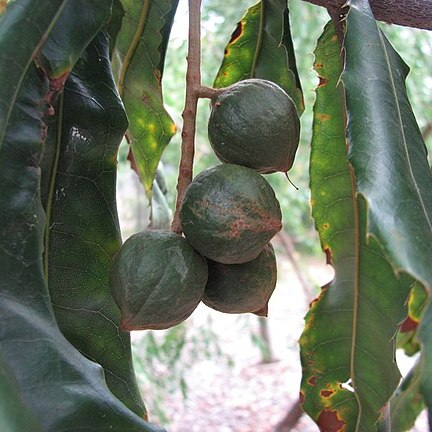Tree 3-18 m tall, often branched near base. Adult leaves in whorls of (3-) 4 (-5); petiole 0-4 mm long; lamina oblong to oblanceolate, 7-30 cm long, 1.4-6 cm wide, semi-glossy above, paler below, rigidly coriaceous, sparsely pilose, glabrescent; bases truncate, attenuate to abruptly attenuate; margin weakly undulate, antrorsely spinose; apices acute or subacute, sometimes mucronate; midrib prominent above and below. Conflorescence simple; rachis 5.5-38 cm long; bracts ovate, 0.2-1.4 mm long. Tepals 5.5-15 mm long, 0.35-0.6 mm wide, cream or pink, free or coherent. Filaments 4-10 mm long, adnate to tepals for 3-8 mm. Anthers 0.8-2.5 mm long. Ovary shortly stipitate, 0.2-1.2 mm long, 0.4-1 mm wide; style 7-12 mm long, 0.2-0.5 mm diam. Fruit globose, 2.4-5 cm long, 1.5-5 cm wide; pericarp 2-9 mm thick. Seeds 2.6-3 cm long, 1.6-2.4 cm wide; testa wrinkled to smooth, 2-6 mm thick.
Small or medium-sized tree, usually with several trunks. Lvs in whorls of (3)-4, subsessile or shortly petiolate. Lamina 12-25 × 3-6.5 cm, narrow-oblong or oblong-obovate, very coriaceous, with undulate, spiny-serrate margins, glabrous except when very young; base ± truncate or broad-cuneate; apex acute or mucronate. Racemes ± = lvs, pendulous, composed of many small fragrant white fls. Peduncle and pedicels densely clothed in rufous hairs; fls in fascicles of 2-4. Perianth 8-10 mm long, rather densely clothed in appressed hairs outside. Anthers 1.7-1.8 mm long, > free portion of filament. Ovary and style densely clothed in rufous hairs. Fr. 2.5-3.5 cm diam., globose, apiculate; endocarp shining brown, thick. Seed large.
A tree which grows 8-15 m high. It spreads to 6-8 m wide. It has a spreading bushy habit. Young growth is red. Young leaves are coarsely toothed. The leaves are 6-30 cm long by 2-5 cm wide. They occur in whorls or rings of 3-5 leaves but usually 4 in a ring. The leaves are stiff and dark green. There are coarse spines on the edge of the leaf. The flowers are in dense stalks 15-45 cm long which hang down from the axils of leaves. The flowers are 1 cm long and slender. They are pink or white and densely hairy. The fruit are 2-3.5 cm across and green and leathery. The nuts are the same size. They are brown and rough. (It produces natural hybrids with Macadamia integrifolia.)
Trees or shrubs, 3-18 m tall. Leaves in whorls of (3-)4(-5); leaf subsessile or with petiole to 4 mm; leaf blade oblong-oblanceolate, leathery, base truncate to ± cordate, margin regularly spiny serrate; apex acute to shortly acuminate. Inflorescences axillary, simple, 5.5-38 cm, densely brownish yellow tomentose; bracts of flower pairs subulate to linear, 0.2-1.4 mm. Pedicel 2-3 mm. Perianth yellowish or pink, 5.5-15 mm, tomentose. Ovary and base of style brownish yellow pubescent. Fruit globose, 1.5-5 cm in diam., apex apiculate. Seed usually 1, testa bony, wrinkled or with shallow depressions. Fl. Mar-Apr, fr. Nov-Dec.


